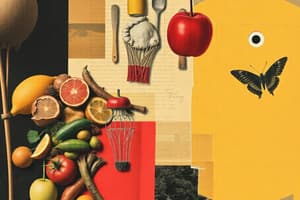Podcast
Questions and Answers
Which of the following is classified as a honey-thick liquid?
Which of the following is classified as a honey-thick liquid?
- Thin liquid
- Mechanical soft solid
- Blended fruits
- Honey-thick liquid (correct)
Which feeding route is included in enteral feeding?
Which feeding route is included in enteral feeding?
- Oral
- Nasogastric (correct)
- Subcutaneous
- Intravenous
What is an absolute contraindication for tube feeding?
What is an absolute contraindication for tube feeding?
- High-output enteric fistula
- Gastrointestinal bleeding
- Intestinal dysmotility
- Mechanical ileus (correct)
Which factor is NOT considered when deciding on the feeding route?
Which factor is NOT considered when deciding on the feeding route?
Which of the following is a natural thickening agent?
Which of the following is a natural thickening agent?
Which type of solid food item is classified as regular solid?
Which type of solid food item is classified as regular solid?
Which of the following is NOT a type of enteral feeding route?
Which of the following is NOT a type of enteral feeding route?
Which of the following thickeners is artificial?
Which of the following thickeners is artificial?
What is a primary concern regarding malnutrition in patients?
What is a primary concern regarding malnutrition in patients?
Which factor does NOT contribute to the development of malnutrition?
Which factor does NOT contribute to the development of malnutrition?
What should prompt a dietary consult according to red flags?
What should prompt a dietary consult according to red flags?
When should nutritional support be considered for a patient?
When should nutritional support be considered for a patient?
What is a potential consequence of treating malnutrition?
What is a potential consequence of treating malnutrition?
Which condition is associated with malnutrition?
Which condition is associated with malnutrition?
What is considered optimal hydration?
What is considered optimal hydration?
What indicates a need for nutritional intervention?
What indicates a need for nutritional intervention?
What is a potential complication of enteral feeding?
What is a potential complication of enteral feeding?
Based on the findings, what effect does an orogastric tube (OGT) have on the incidence of laryngeal aspiration?
Based on the findings, what effect does an orogastric tube (OGT) have on the incidence of laryngeal aspiration?
What was found in the study comparing nasogastric tubes (NGT) and videofluoroscopy swallowing studies (VFSS) in children?
What was found in the study comparing nasogastric tubes (NGT) and videofluoroscopy swallowing studies (VFSS) in children?
Which of the following is NOT a potential complication of enteral feeding?
Which of the following is NOT a potential complication of enteral feeding?
What can occurr due to regurgitation or aspiration during enteral feeding?
What can occurr due to regurgitation or aspiration during enteral feeding?
What effect might nasogastric tubes have during swallowing according to the study's findings?
What effect might nasogastric tubes have during swallowing according to the study's findings?
Which of the following statements about the complications of enteral feeding is true?
Which of the following statements about the complications of enteral feeding is true?
According to the findings, how does an orogastric tube affect aspiration incidence?
According to the findings, how does an orogastric tube affect aspiration incidence?
Flashcards
Malnutrition Definition
Malnutrition Definition
A condition caused by a lack of essential nutrients, either because they aren't consumed enough or the body can't use them efficiently.
Malnutrition Consequences
Malnutrition Consequences
Malnutrition leads to increased healthcare costs, poorer health outcomes, longer hospital stays, higher infection risk, slower recovery, and higher mortality.
Malnutrition Triggers
Malnutrition Triggers
Malnutrition can occur when metabolic needs exceed intake, nutrient intake is reduced, nutrient needs increase, or the body has trouble absorbing nutrients.
Red Flags for Dietary Consult
Red Flags for Dietary Consult
Signup and view all the flashcards
Nutritional Support Timing
Nutritional Support Timing
Signup and view all the flashcards
Nutritional Support Goal
Nutritional Support Goal
Signup and view all the flashcards
Dysphagia Nutrition Concern
Dysphagia Nutrition Concern
Signup and view all the flashcards
Weight Trend Concern
Weight Trend Concern
Signup and view all the flashcards
Oral Feeding Consistencies
Oral Feeding Consistencies
Signup and view all the flashcards
IDDSI
IDDSI
Signup and view all the flashcards
Thickeners
Thickeners
Signup and view all the flashcards
Non-Oral Feeding Routes
Non-Oral Feeding Routes
Signup and view all the flashcards
Enteral Feeding
Enteral Feeding
Signup and view all the flashcards
Parenteral Feeding
Parenteral Feeding
Signup and view all the flashcards
Contraindications of Tube Feeding
Contraindications of Tube Feeding
Signup and view all the flashcards
Feeding Route Decision
Feeding Route Decision
Signup and view all the flashcards
Enteral Feeding Methods
Enteral Feeding Methods
Signup and view all the flashcards
Enteral Feeding Complications
Enteral Feeding Complications
Signup and view all the flashcards
OGT Aspiration Risk
OGT Aspiration Risk
Signup and view all the flashcards
NGT & VFSS Findings
NGT & VFSS Findings
Signup and view all the flashcards
VFSS: What is it?
VFSS: What is it?
Signup and view all the flashcards
VFSS: What does it show?
VFSS: What does it show?
Signup and view all the flashcards
Aspiration: What is it?
Aspiration: What is it?
Signup and view all the flashcards
Respiratory Compromise
Respiratory Compromise
Signup and view all the flashcards
Study Notes
ABCs of Nutrition
- Malnutrition is a pathological condition from the absence of essential nutrients.
- Malnutrition leads to increased healthcare costs, impaired health outcomes, longer hospital stays, higher infection risk, impaired recovery, and higher mortality rates.
- Malnutrition develops when metabolic needs exceed intake, intake is reduced, or nutrient absorption is impacted.
Why be concerned about nutrition in dysphagia?
- Significant weight loss and hydration changes warrant a formal dietary consult.
- Suboptimal dehydration; symptoms such as rapid weight loss, thirst, skin changes, decreased urination, and hypernatremia require dietary intervention.
- A dietician is consulted if weight management goals are not met.
Malnutrition
- Many illnesses and complications, secondary to primary diseases, are linked to reduced nutrition and weight loss.
- Nutritional support is considered if a patient doesn't achieve sufficient oral intake for seven days.
- Nutritional support is also considered if patients are unable to consume at least 60% of their estimated daily nutrient needs.
Nutritional Support
- Timely intervention prevents malnutrition and promotes recovery.
- Treating malnutrition can cause complications via the method of access.
Oral Feeding: Consistencies
- Oral feeding consistencies include liquids (thin, nectar-thick, honey-thick) and solids (puree, mechanical soft, regular).
IDDSI
- The International Dysphagia Diet Standardization Initiative (IDDSI) provides a common terminology to describe food textures and drink thickness for safety.
- The IDDSI framework categorizes foods from liquids to solids.
- Thickening agents are discussed for certain foods as needed.
Thickeners
- Natural and artificial thickening agents are important considerations.
Non-Oral Feeding Routes
- Non-oral feeding solutions include enteral (OG, NG, GT, JTube, ND, NJ) and parenteral feedings.
- Gastrostomy and jejunostomy tubes are examples of tube feedings.
Contraindications of Tube Feeding
- Concerns include Gl function problems like mechanical or paralytic ileus; intestinal obstruction/perforation and other issues such as dysmotility, necrotizing enterocolitis, toxic megacolon, diffuse peritonitis, gastrointestinal bleeding, high-output fistula.
Feeding Route
- Feeding route decisions are based on underlying diseases, the GI tract's functional status, and the enteral feeding's duration and purpose.
What goes through the tube?
- Feeding through a tube can include blenderized food, commercially prepared enteral feeds, and bolus or continuous drip feeds.
Complications
- Tube feeding complications include: clogging, accidental tube removal, infection, abdominal discomfort, nausea, vomiting, and regurgitation or aspiration.
Studying That Suits You
Use AI to generate personalized quizzes and flashcards to suit your learning preferences.




